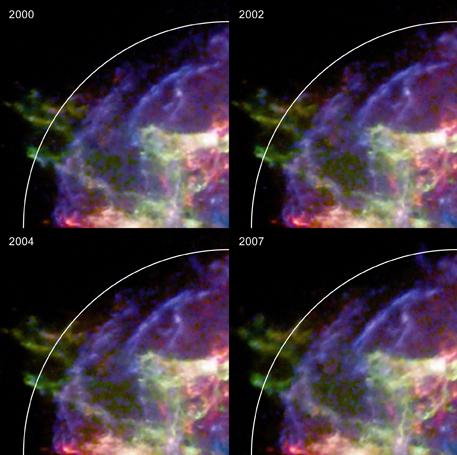
Long Beach, CA
Two new efforts have taken a famous supernova remnant from the static to the dynamic. A new movie of data from NASA's Chandra X-ray Observatory shows changes in time never seen before in this type of object. A separate team will also release a dramatic three-dimensional visualization of the same remnant.
Nearly ten years ago, Chandra's "First Light" image of Cassiopeia A (Cas A) revealed previously unseen structures and detail. Now, after eight years of observation, scientists have been able to construct a movie that tracks the remnant's expansion and changes over time.
"With Chandra, we have watched Cas A over a relatively small amount of its life, but so far the show has been amazing," said Daniel Patnaude of the Smithsonian Astrophysical Observatory in Cambridge, Mass. "And, we can use this to learn more about the aftermath of the star's explosion."
A separate, but equally fascinating visualization featuring Cas A was presented, along with the Patnaude team's results, at a press conference at the American Astronomical Society meeting in Long Beach, Calif. Based on data from Chandra, NASA's Spitzer Space Telescope, and ground-based optical telescopes, Tracey Delaney and her colleagues have created the first three-dimensional fly-through of a supernova remnant.
"We have always wanted to know how the pieces we see in two dimensions fit together with each other in real life," said Delaney of the Massachusetts Institute of Technology. "Now we can see for ourselves with this hologram of supernova debris."
This ground-breaking visualization of Cas A was made possible through a collaboration with the Astronomical Medicine project based at Harvard. The goal of this project is to bring together the best techniques from two very different fields, astronomy and medical
imaging.
"Right now, we are focusing on improving three-dimensional visualization in both astronomy and medicine," said Harvard¹s Alyssa Goodman who heads the Astronomical Medicine proect. "This project with Cas A is exactly what we have hoped would come out of it."
While these are stunning visuals, both the data movie from Patnaude and the 3-D model from Delaney are, more importantly, rich resources for science. The two teams are trying to get a much more complete understanding of how this famous supernova explosion and its remnant work.
Patnaude and his team have measured the expansion velocity of features in Cas A from motions in the movie, and find it is slower than expected based on current theoretical models. Patnaude thinks the explanation for this mysterious loss of energy is cosmic ray acceleration.
Using estimates of the properties of the supernova explosion, including its energy and dynamics, Patnaude's group show that about 30% of the energy in this supernova has gone into accelerating cosmic rays, energetic particles that are generated, in part, by supernova remnants and constantly bombard the Earth's atmosphere. The flickering in the movie provides valuable new information about where the acceleration of these particles occurs.
Likewise, the new 3-D model of Cas A provides researchers with unique ability to study this remnant. With this new tool, Delaney and colleagues found two components to the explosion, a spherical component from the outer layers of the star and a flattened component from the inner layers of the star.
Notable features of the model are high-velocity plumes from this internal material that are shooting out from the explosion. Plumes, or jets, of silicon appear in the northeast and southwest, while plumes of iron are seen in the southeast and north. Astronomers had known about the plumes and jets before, but did not know that they all came out in a broad, disk-like structure.
The implication of this work is that astronomers who build models of supernova explosions must now consider that the outer layers of the star come off spherically, but the inner layers come out more disk like with high-velocity jets in multiple directions.
Cassiopeia A is the remains of a star thought to have exploded about 330 years ago, and is one of the youngest remnants in the Milky Way galaxy. The study of Cas A and remnants like it help astronomers better understand how the explosions that generate them seed interstellar gas with heavy elements, heat it with the energy of their radiation, and trigger shock waves from which new stars form.
Larry Rudnick of the University of Minnesota led the Spitzer part of the Delaney study. NASA's Marshall Space Flight Center in Huntsville, Ala., manages the Chandra program for NASA's Science Mission Directorate in Washington. The Smithsonian Astrophysical
Observatory controls Chandra's science and flight operations from Cambridge, Mass.
Additional information and images are available at:
Headquartered in Cambridge, Mass., the Harvard-Smithsonian Center for Astrophysics (CfA) is a joint collaboration between the Smithsonian Astrophysical Observatory and the Harvard College Observatory. CfA scientists, organized into six research divisions, study the origin, evolution and ultimate fate of the universe.
David A. Aguilar
Director of Public Affairs
Harvard-Smithsonian Center for Astrophysics
617-495-7462
daguilar@cfa.harvard.edu
Christine PulliamPublic Affairs Specialist
Harvard-Smithsonian Center for Astrophysics
617-495-7463
Jennifer J. Morcone
Marshall Space Flight Center, Huntsville, Ala.
256-544-7199
jennifer.j.morcone@nasa.gov
Megan Watzke
Chandra X-ray Center, Cambridge, Mass.
617-496-7998
mwatzke@cfa.harvard.edu